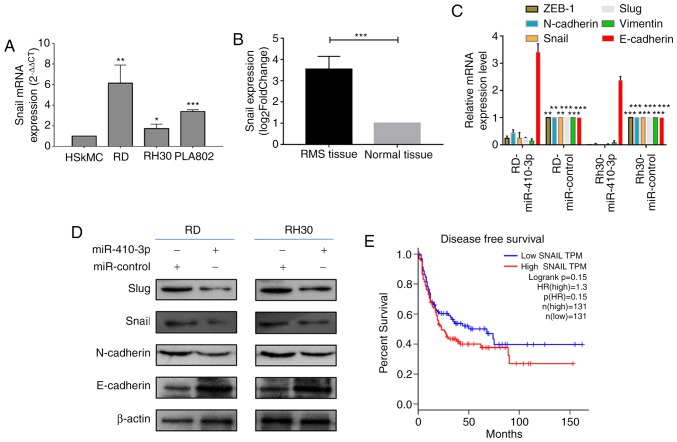Figure 3.
Upregulated miR-410-3p inhibits the expression of EMT-associated molecules. (A) RT-qPCR was used to investigate Snail mRNA expression levels in HSkMCs and the three RMS cell lines. GADPH was used as an internal reference. *P<0.05, **P<0.01 and ***P<0.001 vs. HSkMC. (B) miR-410-3p expression levels in RMS (n=101) and normal skeletal muscle tissues (n=5) were obtained from the GSE108022 dataset. ***P<0.001 (C) RT-qPCR was used to determine mRNA expression levels of EMT-associated molecules, including Snail, Slug, zinc finger E-box binding homeobox 1 (ZEB1), vimentin, E-cadherin and N-cadherin, in RMS cells following 48 h of transfection with miR-410-3p. GADPH was used as an internal reference. **P<0.01 and ***P<0.001 vs. corresponding control. (D) Western blot analysis was used to detect the expression of EMT-associated molecules in RMS cells following 48 h of transfection with miR-410-3p. β-actin was used an internal control. (E) Kaplan-Meier survival analysis of the DFS of patients with sarcoma whose DFS information was available in The Cancer Genome Atlas sarcoma dataset. The patients were divided into high and low Snail expression groups. No significant difference was observed in the DFS rate between the two groups. All experiments were performed three times. miR, microRNA; EMT, epithelial-mesenchymal transition; RT-qPCR, reverse transcription-quantitative polymerase chain reaction; HSkMC, human skeletal muscle cells; DFS, disease free survival; RMS, rhabdomyosarcoma; HR, hazard ratio; ZEB-1, zinc finger E-box binding homeobox 1.

